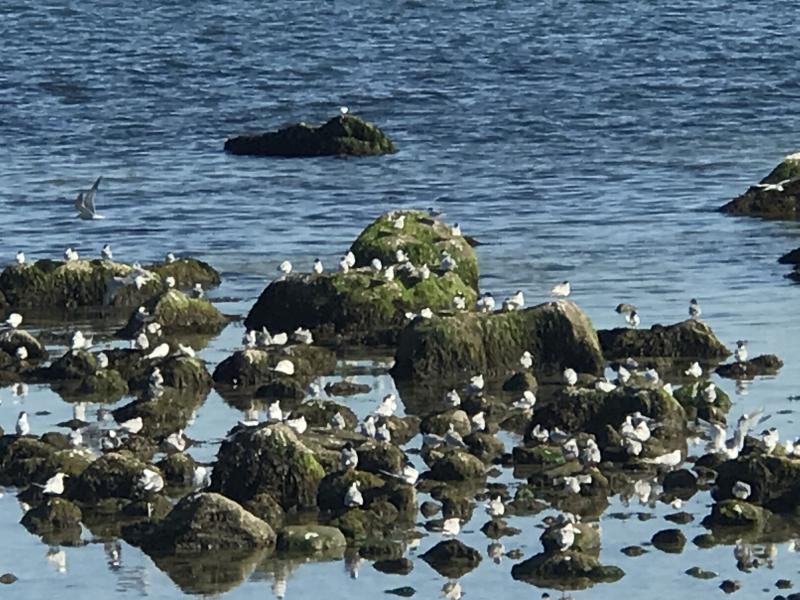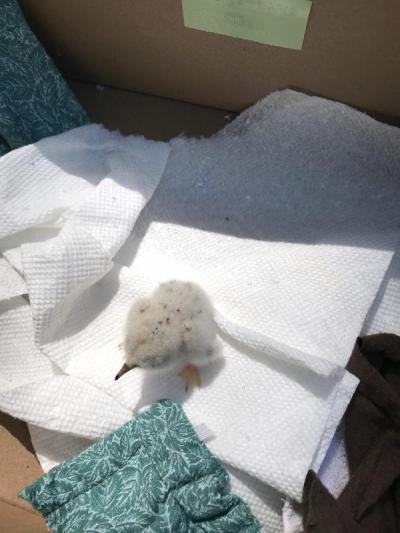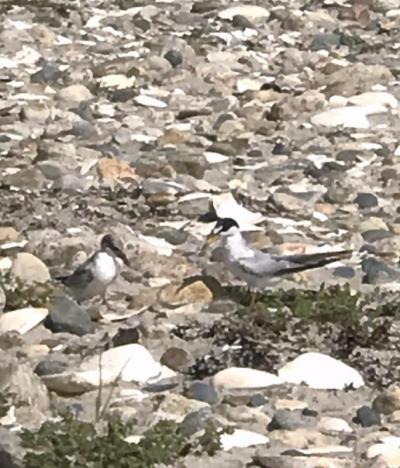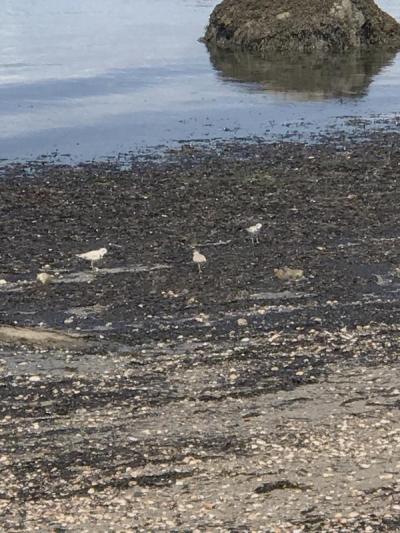Transplanted Least Tern Chick Survives to Fledge by Jamie Bogart, Lloyd Center Research Associate
Every August, shorebird staff take part in an end-of-season meeting when cooperators share results from the different regions of Massachusetts and the rest of the Atlantic Coast. Around this time we offer the summary of our sites, as we did a month ago in our Lloyd Center for the Environment shorebird “wrap-up”, as by late July only a few unfledged chicks remain, and major events have come and gone. As it turns out, the remaining birds had stories worthy of one final update.
On the plover front, we reported some late hatches on the Department of Conservation and Recreation (DCR) property at West Island, including two hatchlings from a renest near the estuary inlet nearly fledged and which did survive, enjoying a productive food source that the estuary inlet mouth provides. We also reported a more recently hatched brood that had renested multiple times, hatching on the fourth overall attempt and third on DCR property. We can report that the three chicks reached the 25 day fledge date on August 15th, with flight observed on August 20th at 30 days. With more sand on DCR land, including new habitat used by this pair, and plenty of nesting space on the sand spits and low dune habitat of the town beach, we can expect much of the island’s perimeter to be used by plovers for the foreseeable future.
The additional monitoring on West Island occurred during the post-breeding phase of Common Terns, which have colonies at Ram, Bird, and Penikese Islands; Penikese having a record colony this year that featured good productivity. Anywhere from 50-100 fledges, and sizable concentrations of adults from these islands, gathered at a time at two separate points at low tide as they do each year at West Island, which is a stopover site after nesting on the offshore islands.
The highly endangered Roseate Terns also nest on these islands and mix in with the flocks. The terns draw interest from beachgoers and depict the ecological importance of the near shore waters of Nasketucket Bay as a food source for fish eating birds. Laughing Gulls, island nesters which congregate in small numbers with the terns in late summer, also show up. Back in late May, the less common Black Terns which breed further north near freshwater marshes passed through, and in early spring hundreds of Northern Gannets, commonly seen diving on whale watches, passed through one day after a storm when fish were abundant. The smaller Least Tern, which nests on the mainland and shares habitat with plovers, while not forming a small colony as it did in 2018 on the island, is a common offshore sight all season, and incidentally, is the subject of the feel-good story of the season.
In July, a least tern chick (picture) was brought to the Lloyd Center from Allens Pond (Barneys Joy) by a well-meaning individual who feared the bird was sick or injured. In the early stages, a young shorebird laying on the sand or near water appears vulnerable. Young birds from many species found away from nesting areas are often presumed ill or abandoned, but parents always know where they are and usually they are fine. Also while plover chicks are rarely far from a parent, Least Tern chicks tend to venture off and plop down in odd places, seeming abandoned by parents which must go out to sea to catch fish. Whether healthy or not (no obvious cues to sickness existed), the bird needed to be returned to the beach for any chance of survival. Lloyd Center education staff looked after the bird briefly, but time was of the essence and a convenient destination was nearby Horseneck Beach, where a small number of least tern pairs were still present and where DCR staff, with whom we were currently collaborating, were prepared to receive the bird.
Least Terns first found Horseneck’s main beach in 2012 - we think concurrent with a decline in birds at Allen’s Pond, where overwash and predation were taking their toll. Over a five-year span from 2013-2017, numbers surged to nearly 100 pairs, including a sizeable sub-colony that nearly overtook the main public beach. Since that time, liming factors of recreational activities, predation, and a resurgence of the Allen’s Pond colony have resulted in a decline at Horseneck. Least Terns are still nesting at the beach however.
The chick was brought to Horseneck Beach by Lloyd Center staff, then handed over to DCR shorebird staff that brought it to a location where a few pairs remained and might show interest, and progress could be monitored. We are happy to report that the parents accepted the bird, and on August 24th (pic) the nearly-fledged tern chick was attempting small flights and will soon learn to feed on its own. We’ll assume and hope it survives to fly south for the winter, after surviving human hands, a trip in a vehicle (while resting in a binocular case), and new parents. But the ultimate outcome isn’t what makes this story significant (and unlike plovers for which all fledges are tallied, productivity of state-listed Least Terns is assessed more generally, not based on survival of every bird). For the record, we applaud the individual for bringing us the bird and we of course, thank DCR shorebird staff for receiving and checking on the bird for the rest of the monitoring season at Horseneck. If the bird were initially in harm’s way, and no staff were present at the time to assess the situation, this was the correct action and all’s well that ends well.
This however, also brings to light an ongoing issue, when these presumably healthy shorebird hatchlings (both tern and plover) are encountered close to the water by passing beachgoers who may be drawn to them. Many people familiar with the fencing might not associate the hatchlings with the refuge, or might see a young chick before they even encounter a refuge area or its signs (and signs highlighting the chicks are less available).
The bird’s status when encountered by a beachgoer may be no different than the crab or surf clam that crosses their path on their walk. The general message (to ponder in the winter offseason) is that from late May through August on the beaches, almost every young bird seen near the water, hatched from a refuge area up on the beach protecting endangered shorebirds regulated bylaws, is most likely healthy. The “leave young wildlife alone” rule applies here, the endangerment status only increasing the urgency to do the right thing. These instances of attempting to help shorebird hatchlings are not uncommon, and this brings to mind a West Island event a couple years back, when beachgoers thought plover hatchlings near the water were in need of assistance. Had the plover monitor not been present, the entire brood may have been “rescued” and “brought to safety” on high ground. The folks, after being informed, were thankful and interested in our efforts, and the handled plover survived.
As the populations of these birds increase as a result of our efforts, encounters of various types with young birds will only become more common. We can only hope more of them end like this story, as we continue our protection efforts. We are thankful to all involved with this highly unique event, and wish the bird a safe trip south!

















